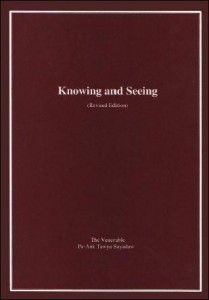
Knowing and Seeing is a set of precise and detailed instructions on realising Nibbāna in this very life as it is developed and practised at the Pa-Auk Forest Monastery in Myanmar. From the foreword:
To achieve Nibbāna yogis must comprehend the aggregates, as impermanence, suffering, and non-self. As for the objects of Vipassanā meditation, they are not only the internal and external five aggregates, but also the five aggregates of past, future and present, gross and subtle, superior and inferior, far and near. Only after comprehending all of them penetratively as impermanence, suffering, and no-self, can yogis attain the noble paths. Then they continue to practise Vipassanā to attain the higher paths and fruitions up to Arahantship, whereby they are no longer subject to rebirth, and will attain final Nibbāna after death. Download the free ebook here (346 pages):
 Knowing and Seeing
Knowing and Seeing
What is The Pa-Auk Forest Monastery?
The Pa-Auk Forest Monastery, also known as Pa-Auk Tawya, is a Theravāda Buddhist monastery located in the Pa-Auk Forest of Myanmar (Burma). It is one of the most renowned meditation centers in the country and is known for its comprehensive and detailed approach to meditation based on the Visuddhimagga, a classic meditation manual.
Here are some key points about the Pa-Auk Forest Monastery:
- Location: The monastery is situated in the Pa-Auk Forest near the town of Mawlamyine in Mon State, Myanmar.
- Teachings: The primary meditation method taught at Pa-Auk is based on the Visuddhimagga (The Path of Purification), which provides detailed instructions on both samatha (tranquility) and vipassanā (insight) meditation practices. The monastery is known for its systematic and rigorous approach to meditation.
- Venerable Pa-Auk Sayadaw: The monastery is under the guidance of the Venerable Pa-Auk Sayadaw, who is a highly respected meditation master in the Theravāda tradition. He has been instrumental in spreading the teachings of the Visuddhimagga to both Eastern and Western practitioners.
- International Community: Due to its reputation, the Pa-Auk Forest Monastery attracts meditators from all over the world. As a result, it has a diverse community of monks, nuns, and laypeople from various countries.
- Daily Routine: The daily routine at the monastery typically includes periods of meditation, chanting, alms rounds, and dhamma talks. There’s a strong emphasis on maintaining silence and mindfulness throughout the day to support deep meditation practice.
- Branch Monasteries: Over the years, several branch monasteries and meditation centers affiliated with Pa-Auk Tawya have been established in various countries, allowing more people to access the teachings and practices.
- Lifestyle: The lifestyle at the monastery is simple and austere, in line with the monastic code of the Theravāda tradition. This simplicity is intended to minimize distractions and support the deepening of meditation practice.
The Pa-Auk Forest Monastery continues to be a beacon for those seeking a thorough and traditional approach to Buddhist meditation.

